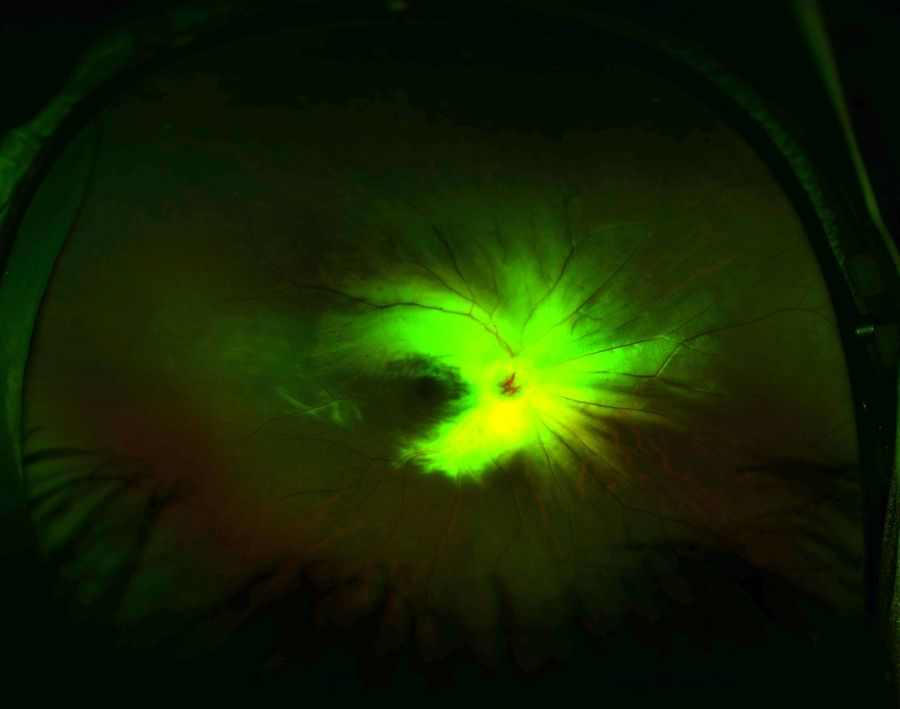Straatsma Syndrome
All content on Eyewiki is protected by copyright law and the Terms of Service. This content may not be reproduced, copied, or put into any artificial intelligence program, including large language and generative AI models, without permission from the Academy.
Disease Entity
Disease
Straatsma syndrome is a rare disease entity characterized by the traditional triad of unilateral myelinated retinal nerve fibers (MNRF), axial myopia, and amblyopia.[1] The original description of the condition also included strabismus[2] Variations of the triad include a “reverse Straatsma syndrome ”, in which patients exhibit hyperopia instead of myopia.[1] Even though nystagmus and strabismus have not been prominently associated with Stratsma syndrome, either may be present as complimentary findings without precluding one from the diagnosis.[1] Even though Straatsma syndrome has traditionally been considered a unilateral disorder, cases of bilateral Straatsma syndrome[3] and bilateral reverse Straatsma syndrome have also been reported in literature.[4]
History
Bradley R Straatsma et al[2] first described Straatsma syndrome in 1979 in a case series of 4 patients exhibiting unilateral MRNF in association with myopia, amblyopia, and strabismus. In a series of 3,968 consecutive autopsy cases, Straatsma and colleagues reported that MRNF were present in 0.98% of patients and in 0.54% of eyes examined, with bilateral involvement in 7.7% of patients. Multiple distinct lesions were found in the same eye in 12% of specimens
First described by Virchow in 1856,(1) myelinated nerve fiber appears at fundoscopy as white striated opacities, following the distribution of retinal nerve fibers. They are usually benign (2) and diagnosis is usually made by chance. In some cases it can be associated with other conditions, such as neurofibromatosis and vitreoretinal disorders.(3) Patients are usually asymptomatic, but a few cases can present significant visual abnormalities, in special axial myopia and amblyopia, configuring the Straatsma Syndrome. We report a case of a 60 years old female patient with this rare syndrome.
Etiology
Myelination of retinal nerve fibres (MRNF) is rare, with an estimated occurrence of approximately 1% in all autopsied eyes, and 0.3%-0.6% in routine ophthalmic outpatient department.[5] MRNF can be associated with multiple clinical pathologies, such as myopia, amblyopia, and strabismus, as well as other systemic conditions. However, in the majority of patients MRNF is an incidental stagnant findings. A few cases have reported progression of the disease.[6] The pathogenesis of this condition is not fully understood: myelination starts at the 5th month of pregnancy, and it is complete before birth. The lamina cribosa acts as a barrier for the myelination.
Diagnosis
MRNF appear as white lesion usually contiguous with the optic nerve head. The distribution is along the retinal nerve fiber layer and typically feather like appearance is noted at the margin. The MRNF does not cross the horizontal raphe. MRNF may be separate from the optic disc and may be present in the peripheral retina.
Despite some controversy in its diagnostic features, it should be included in the differential diagnosis of leukocoria and must be suspected in the presence of refractive errors with anisometropia[7]
Management
The management includes providing proper refractive correction and ruling our systemic associations.
Prognosis
Visual prognosis of amblyopia associated with myelination of retinal nerve fibers and anisometropia is poorer than anisometropic amblyopia without myelination. It is well known that the former is refractory to occlusive therapy. Despite having a poor prognosis, visual rehabilitation should be attempted.
References
- ↑ Jump up to: 1.0 1.1 1.2 Juhn, A. T., Houston, S. K., & Mehta, S. (2015). BILATERAL STRAATSMA SYNDROME WITH NYSTAGMUS. Retinal Cases & Brief Reports, 9(3), 198–200. doi:10.1097/icb.0000000000000137
- ↑ Jump up to: 2.0 2.1 Straatsma BR, Heckenlively JR, Foos RY, Shahinian JK. Myelinated retinal nerve fibers associated with ipsilateral myopia, amblyopia, and strabismus. Am J Ophthalmol. 1979 Sep;88(3 Pt 1):506-10. doi: 10.1016/0002-9394(79)90655-x. PMID: 484678.
- ↑ Shenoy R, Bialasiewicz AA, Al Barwani B. Bilateral hypermetropia, myelinated retinal nerve fibers, and amblyopia. Middle East Afr J Ophthalmol 2011;18:65–66
- ↑ Levy NS, Ernest JT. Retinal medullated nerve fibers. Arch Ophthalmol 1974;91:330–331
- ↑ Congenital optic disk anomalies [Internet]. W.B. Saunders; 2013 [cited 2021 May 19]. Available from: https://www.sciencedirect.com/science/article/pii/B9780702046919000510
- ↑ Rosen B, Barry C, Constable IJ. Progression of myelinated retinal nerve fibers. Am J Ophthalmol. 1999 Apr;127(4):471-3. doi: 10.1016/s0002-9394(98)00377-8. PMID: 10218709.
- ↑ Quezada-Del Cid NC, Zimmermann-Paiz MA, Ordoñez-Rivas AM, Burgos-Elías VY, Marroquin-Sarti MJ. Straatsma syndrome: Satisfactory amblyopia treatment. Report of two cases. Arch Soc Esp Oftalmol. 2018 Jun;93(6):300-302. English, Spanish. doi: 10.1016/j.oftal.2017.12.010. Epub 2018 Feb 15. PMID: 29398227.


